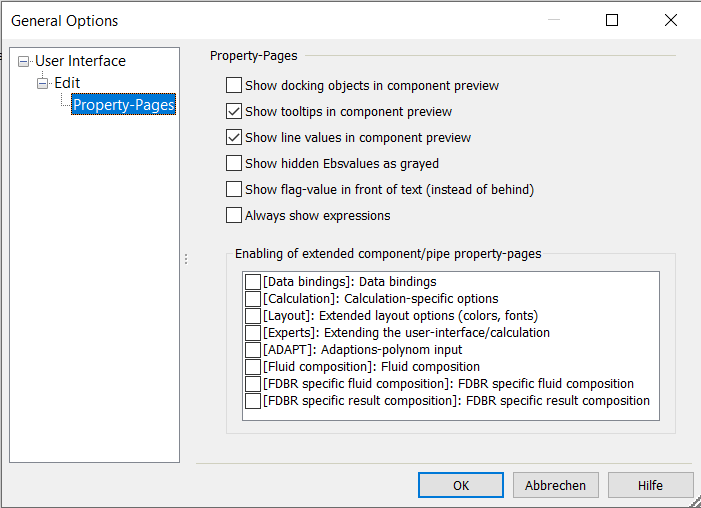

Compositions can be specified via boundary values and start values respectively (Component 1 and 33 respectively) or via measured values (Component 46).
The specification via measured values is required only when a validation (data reconciliation) of the composition needs to be carried out.
Some basic material properties to be used can be set on a model-wide basis. These material properties can be overwritten for each fluid used in a model with components 1 and 33. E. g. the formulation of the gas table to be used can be set in the model options for all streams of the model. Otherwise the formulation of the gas table can be changed for one of the fluids of the model. Example: You can use the formulation FDBR for air and flue gas streams, but "VDI 4670" for natural gas used as a fuel.
When the complete composition is specified via a boundary and start value, it is checked immediately whether the total of all substances results in 1. If that is not the case, an error message will be generated.
When specifying via measured values, one measured value is to be placed on the line for each occurring substance. In addition, one boundary and start value respectively is required on the same line in order to provide the additional information that cannot be defined via measured values (e.g. the coal type or cp coefficients for the user-defined fluid). In this start value one also needs to specify that when integrating the material equations into the equation matrix, equations with the value 0 are provided for the unspecified substances (otherwise one would have to set a measured value with the value 0 for each substance that is not contained).
See specification combo box (left side: property sheet "start value"): for example, only material-integration-mode: set unspecified to zero (16)
If the total of all measured values does not result in 1, an error message will be output.
If you use component 1, switch the stream type (in the ”Ports” tab of the property sheet) to one of the listed stream types.
If you use component 33 or component 46, just place the component on a stream.
Material tables are available for all stream types:
There are several ways to view, define or change a substance data definition in the component properties dialog of a component 1 or 33 resp..
The ‘Material Fractions' property sheet is visible and selectable by default.
There are also these other property sheets
Open the ‘Material Fractions’ page of the property sheet of a component 1 (or 33).
On the left-hand side, the "Material Fractions" sheet is selected in the tree structure.
In the centre there is a large table, the info field. The FFLSET-combobox is arranged above it.
On the right-hand side is the composition table.
The content of both tables depends on the fluid type; in the example here, a classic, i.e. a classical FDBR fluid type is used (gas stream).
The most important material value definition specifications (fluid coefficients, calorific value data) are listed in the centre info field.
This list does not include the short names of the default values as they can be used in an EbsScript, for example. Therefore some important short names are also shown in the figure above.
To see all short names, proceed as follows: At the bottom of the properties dialog, there is a selection button ‘Options / Default values’, among others. If you click on this, this list appears:
Just click on ‘Enabling of extended property pages...’ and select the three fluid composition pages listed above in the following dialogue.

Two additional entries are now visible in the tree on the left-hand side of the properties dialog under Specifications values.
One (‘Fluid composition’) shows the centre table of the "Material Fractions" properties page (fluid coefficients, calorific value data), the other (‘FDBR-specific fluid composition’) shows the right-hand table of the "Material Fractions" page.
The short names are also listed in these properties pages.
All three property pages are now also displayed under the results in the properties dialogue of a stream.
Many of the specification values listed are not used for the calculation, depending on the fluid type, but are still displayed. In the example here - a classic gas pipe - SALT, FMED and FBIN, among others, are not relevant.
In the profile structure, the composition is inherited like other specification values. But there are some differences:
The entry "Load default values..." of the "Options/Default values.."-button is loading a predefined composition from the default values database. Below the button, the name of the last loaded composition dataset is displayed.
Input - Combo Box (left side, about information field and composition field): This defines, which of the values defined in this component are used for calculation and which not.
The following selection is possible:
In case of 0 not any fluid values are used for any calculation. In case of 1 all fluid values defined here will be used for any calculation. Cases 2 to 12 define a subset of all values to be used.
Selection from 16 on is only for the use of material equations for simulation or validation in the matrix solution method.
See : EBSILON - Menu: Extras --> Model Options --> Simulation --> Iteration
The input field of the composition is used to specify the composition of your fluid according to the settings mentioned above. If you select a line and click on the number, the field becomes editable and you can type a new value. If one or more lines are selected in this table, the right mouse button offers certain convenient features:
With the universal fluid, the library to be used can also be changed subsequently in the input mask.
See chapter Heating value .
